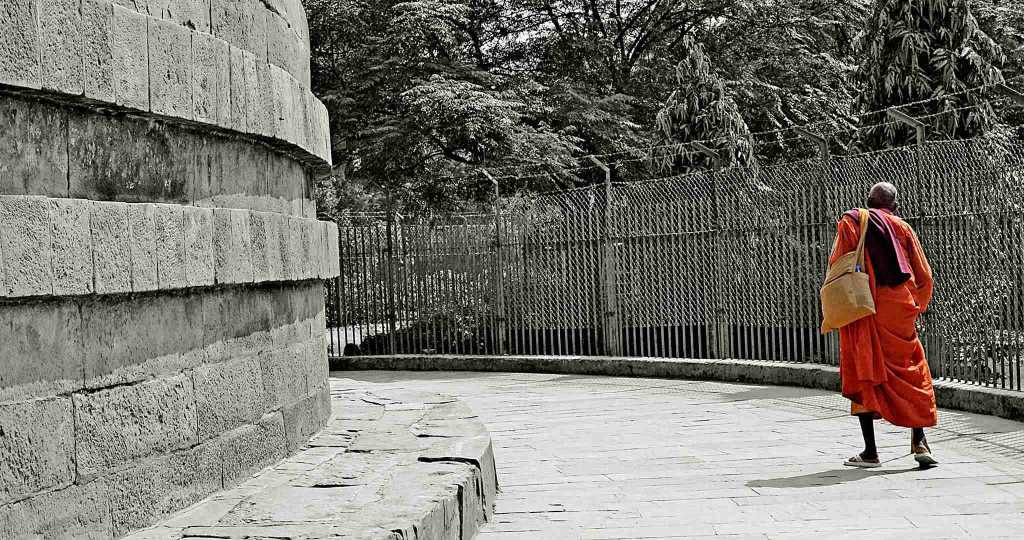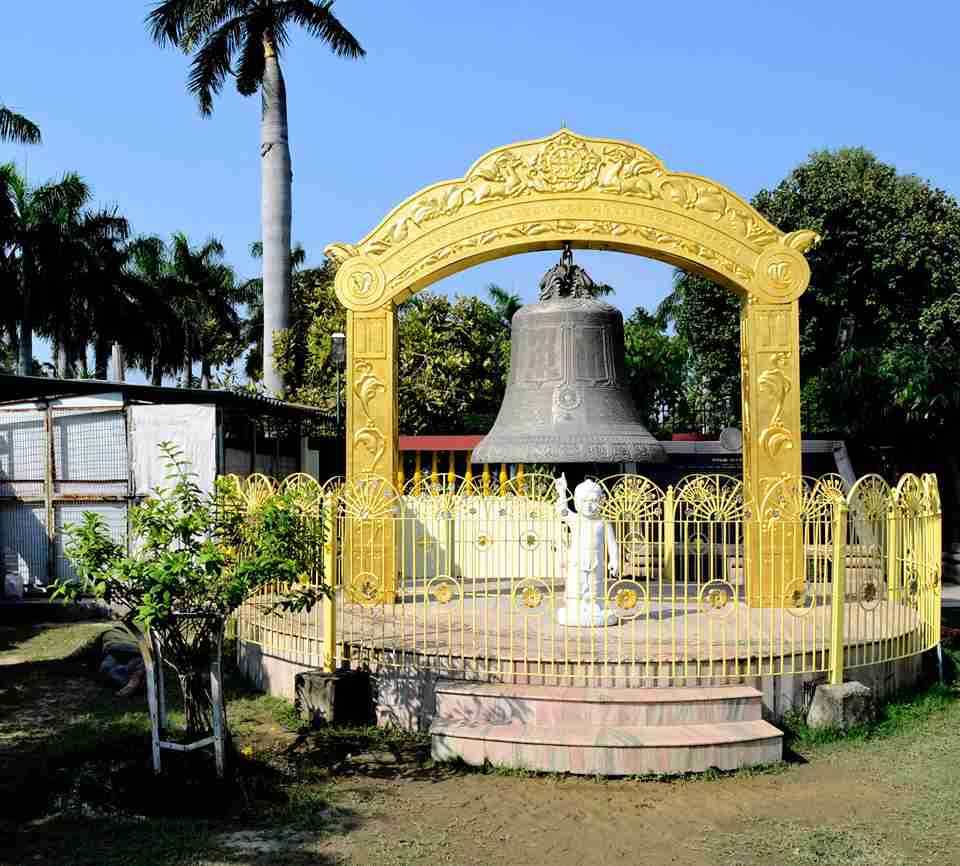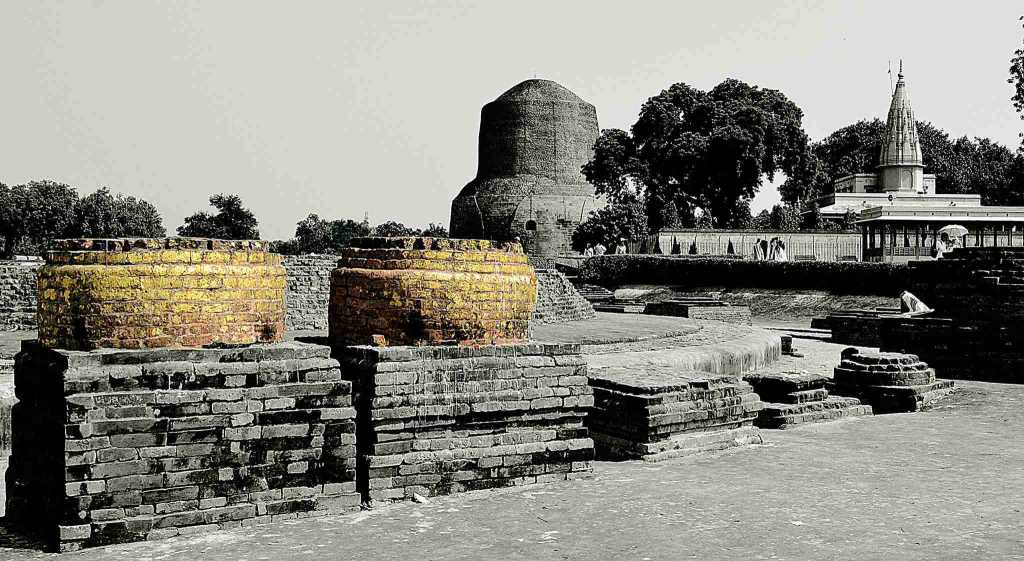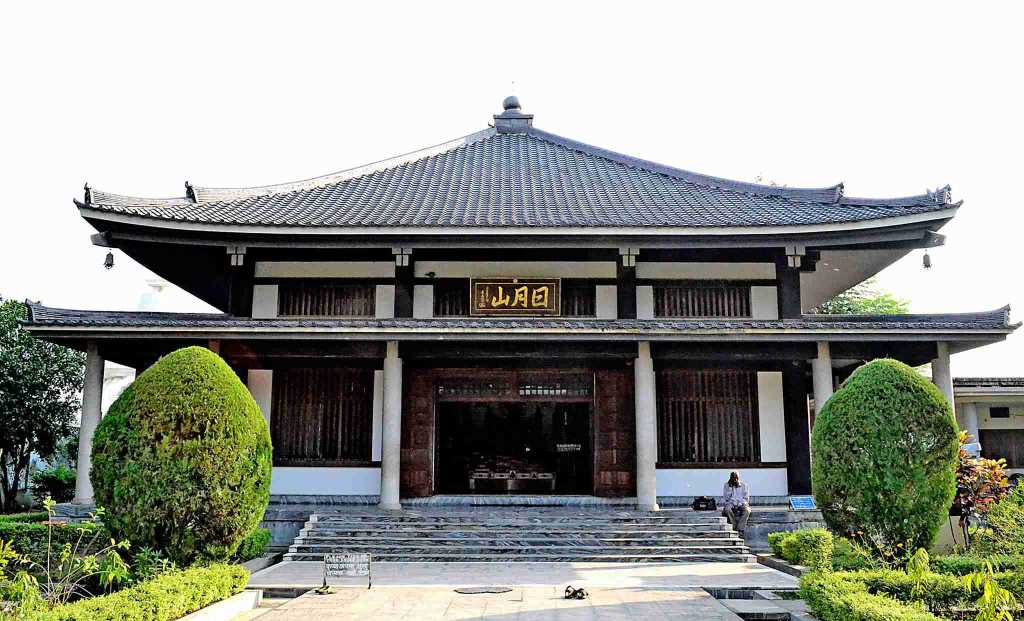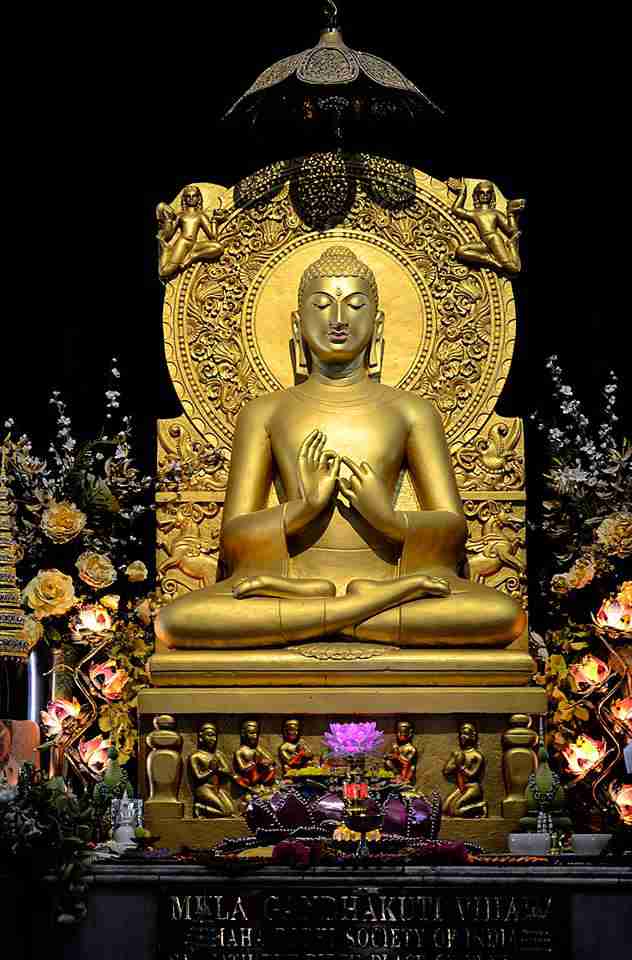Sarnath…..Where Lord Buddha Taught Dharma
Sarnath.. or Sarangnath..or Mrigdava.. or Isipatana .. a journey through the pages of History.. Religion..”Sarnath..Where Buddha Taught Dharma”
Sarnath, one of the most important religious places for the followers of Buddhism, located just 12 km from the Hindu holy city of Varanasi, is the site of the deer park where Gautama Buddha first taught the Dharma after his enlightenment. Sarnath is one of four holy Buddhist sites sanctioned by the Buddha himself for pilgrimage. The other three sites are: Lumbini (birth); Bodh Gaya (enlightenment); and Kushinagar (death). Sarnath is also home to a number of Buddhist temples, belonging to different Buddhist countries.
Mrigadava
Sarnath was previously known as Mrigadava (deer park) and Isipatana, meaning the place where holy men fell to earth. The latter name is based in the legend that when the Buddha was born, ‘Devas’ came down to announce it to 500 holy men. The holy men all rose into the air and disappeared, and their relics fell to the ground.
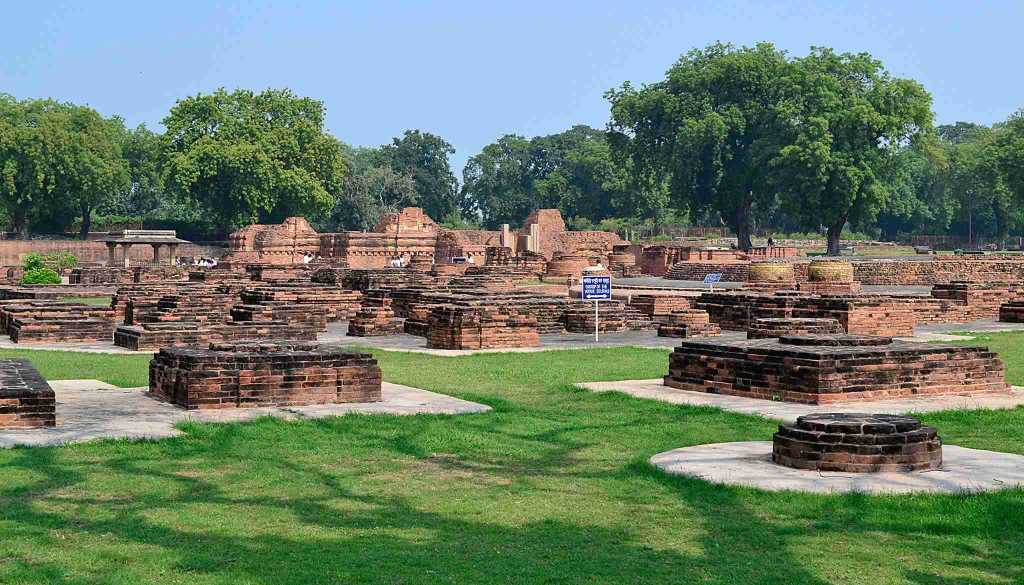
Saranganath tended to Sarnath
The current name Sarnath, from Saranganath, means “Lord of the Deer” and relates to another old Buddhist story in which the Bodhisattva is a deer and offers his life to a king instead of the doe he is planning to kill. The king is so moved that he creates the park as a sanctuary for deer.
After attaining enlightenment Buddha traveled to the Isipatana to teach his friends and was able to make them understand the Dharma. His friends also became enlightened. That was the time when Sangha, a community of enlightened ones got its existence.
Buddha spent the next rainy season in Sarnath at the Mulagandhakuti vihara. The Sangha having grown to 60 in number, the Buddha sent them out to teach the Dharma to others. Buddhism flourished in Sarnath in part because of the support of kings and wealthy merchants based in nearby Varanasi. By the 3rd century Sarnath had become an important center for the arts, which reached its zenith during the Gupta period (4th-6th century AD). When Hsuan Tsang visited from China in the 7th century, he found 30 monasteries and 3000 monks living at Sarnath.
Sammatiya school of Buddhism at Sarnath
Sarnath became a major center of the Sammatiya school of Buddhism, one of the Nikaya or Hinayana schools. The presence of images of Heruka and Tara indicate that Vajrayana Buddhism was also practiced here. At the end of the 12th century, Sarnath was sacked by Turkish Muslims. The site was subsequently plundered for building materials and has remained in ruins until the present day. The site was entirely deserted until 1836, when the British began excavations and restoration.
Dhamekh Stupa at Sarnath
All of the ancient buildings and structures at Sarnath were damaged or destroyed by the Turks. However, amongst the ruins the Dhamekh Stupa is impressive at 128 feet high, and 93 in diameter. This dates from around 200 BC and is the spot where the Buddha is said to have preached his first sermon.
Only the foundations remain of the Dharmarajika Stupa, but it is notable as a rare pre-Ashokan stupa.
The decaying ruins of the Mulagandhakuti Vihara mark the place where the Buddha spent his first rainy season in meditation. In the 7th century, a writer described it as 200 feet high and containing 100 niches containing a Buddha carving along each wall. A life-sized statue shows the Buddha turning the wheel of the law.To the east is the modern Mulagandhakuti Vihara with its beautiful wall paintings; behind it is the Deer Park, which is maintained as an open animal park and still attracts deer.
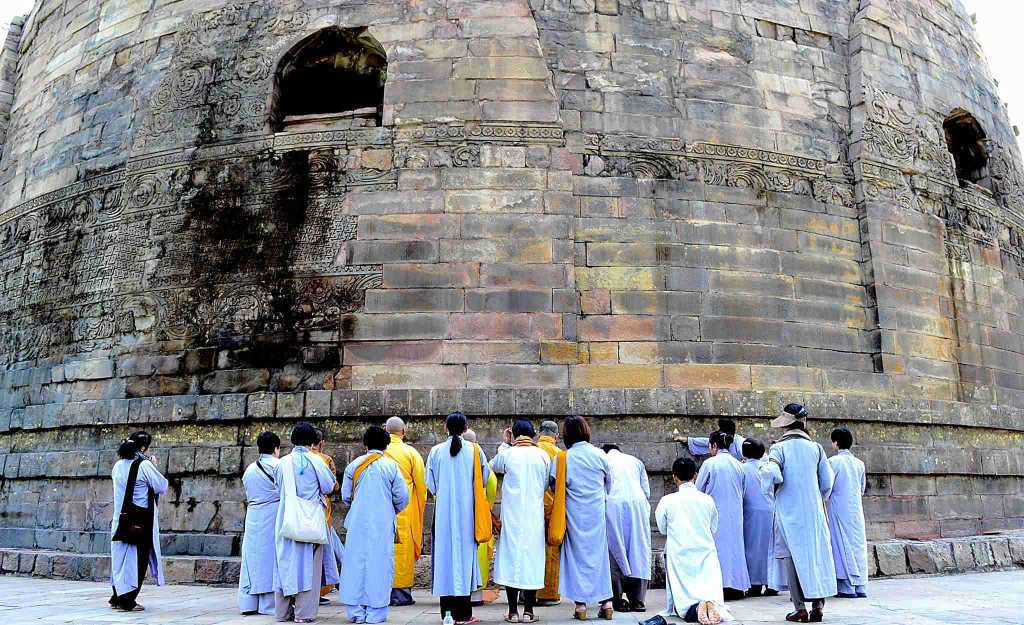
The Ashoka Pillar at Sarnath survived the Turkish invasion but was broken during excavations. The base still stands in its original spot and has some interesting carvings. The splendid lion capital that topped the pillar, which thankfully survived its 45 foot drop to the ground is on display at the Sarnath Archeological Museum. The museum also houses some of the greatest treasures of Indian Buddhist art, including almost 300 images.
Bodhi Tree at Sarnath
There is also a Bodhi tree planted by Anagarika Dharmapala which was grown from a cutting of the Bodhi tree at Bodh Gaya. It is located next to a Sri Lankan monastery. Here is a number of National temples or Monasteries have been built by various Asian communities at Sarnath since the site’s restoration, including a Tibetan temple and Sri Lankan temple, apart from Buddhism, Sarnath is also an important pilgrimage and sacred place for Jains. Shreyansanath, the eleventh Tirthankara of Jainism was born at Singhpur, a village just adjacent to Sarnath. A temple dedicated to Shreyansanath is located at the place of his birth. Thousands of followers of Jainism also visit Sarnath every year.
Main attractions of Sarnath :
Dhamekh Stupa & Monastery Ruins
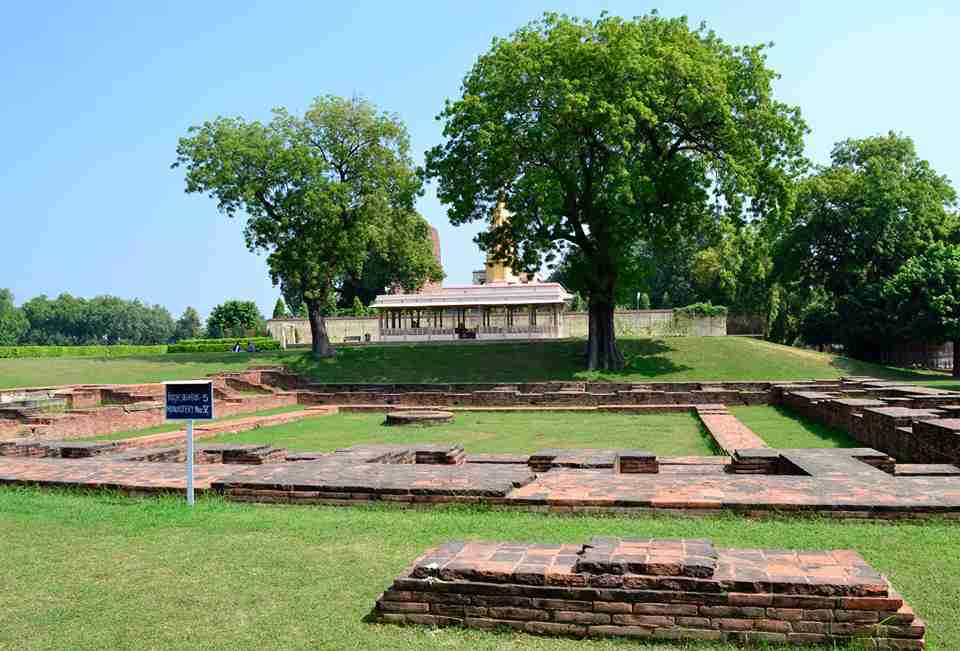
Set in a peaceful park of monastery ruins is the impressive 34m Dhamekh Stupa, which marks the spot where the Buddha preached his first sermon. The floral and geometric carvings are 5th century AD, but some of the brickwork dates back as far as 200 BC.
Nearby is the 3rd-century BC Ashoka Pillar , with an edict engraved on it. It once stood 15m tall and had the famous four-lion capital (now in the museum) perched on top of it, but all that remains now are five fragments of its base.
Archaeological Museum
This fully modernized, 100-year-old sandstone museum houses wonderfully displayed ancient treasures such as the very well preserved 3rd-century BC lion capital from the Ashoka Pillar, which has been adopted as India’s national emblem, and a huge 2000-year-old stone umbrella, ornately carved with Buddhist symbols.
Mulgandha Kuti Vihar

This modern temple was completed in 1931 by the Mahabodhi Society. Buddha’s first sermon is chanted daily, starting
between 6pm and 7pm depending on the season. A bodhi tree growing outside was transplanted in 1931 from the tree in Anuradhapura, Sri Lanka, which in turn is said to be the offspring of the original tree in Bodhgaya.
Choukhandi Stupa
The Chaukhandi Stupa is thought originally to have been built as a terraced temple during the Gupta period between the 4th to 6th Century to mark the site where Lord Buddha and his first disciples met traveling from Bodh Gaya to Sarnath. Later Govardhan, built by Goverdhan, the son of Raja Todarmal in 1588 AD to commemorate the visit of Humayun to this place.
Digambar Jain Temple and Birthplace of Jain Tirthankara Shreyansanath

Singhpur, a village just beside the Buddhist site, was the birthplace of Shreyansanath, the eleventh Tirthankara ofJainism, and a temple dedicated to him, is an important pilgrimage site for Jian peoples..
Thai Monastery and Buddha Statue
One of the main attractions of Sarnath is the 80 ft high statue of Buddha. It isIndia’s tallest standing statue of Lord Buddha. It took 14 years to contruct this statue. The work on the statue was started in 1997 and it was unveiled in 2011. This standing statue of Buddha is located on the premises of Thai Buddha Vihar in Sarnath.
Burmese Monastery

Located on the west side of Dhamek Stupa on the road leading to Khajuhi village in Sarnath, Varanasi, U.P., India. The temple is located inside the Burmese Monastery and has been built by Monk Daw Ryu & Daw Goom from Burma in 1934. A Buddha idol made of white marble & flanked by his two disciples is installed in the sanctum of the temple. A Vihar built in 1910, adjacent to the temple, is meant for Burmese people only. (Timing: 6am-6pm)
Bodhi tree and Srilankan Monastery
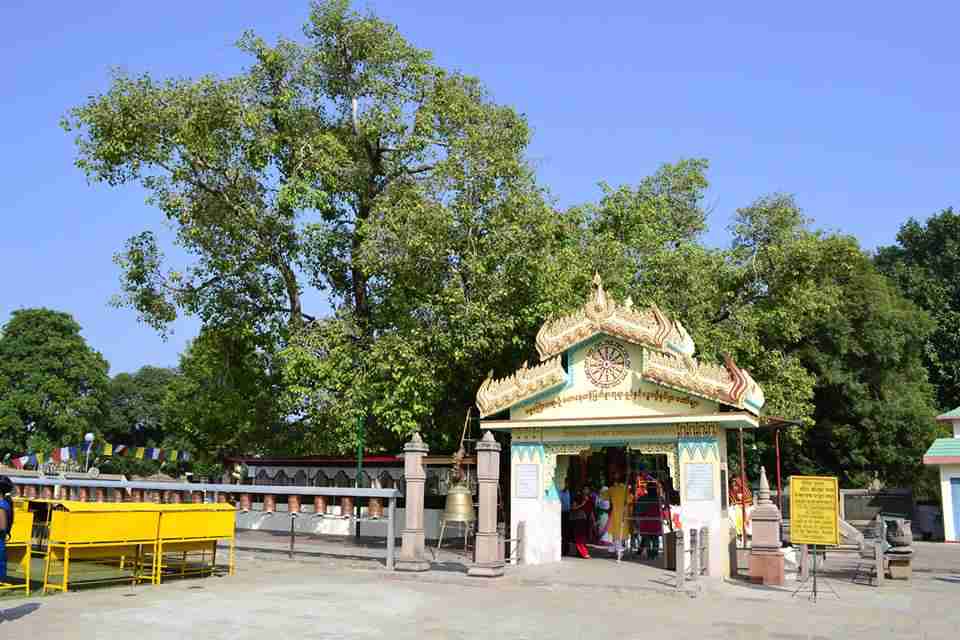
Here is also a Bodhi tree planted by Anagarika Dharmapala which was grown from a cutting of the Bodhi tree at Bodh Gaya. It is located next to a Sri Lankan monastery, few meters away from the Mulagandhakuti Vihara temple.The holy Bodhivriksha (the Bodhi Tree) is considered as the most sacred tree for Buddhists as Lord Buddha attained enlightenment sitting under this tree only. The Bodhi Tree of Sarnath was planted from a branch taken from the Sri Maha Bodhi tree ofAnuradhapura,Sri Lanka.
Tibetan Monastery

The Temple is one of the famous Buddhist places and is in the conventional Tibetan architectural manner which houses the statue of Shakyamuni, the Buddha. It is famous for its beautiful paintings, Thangksa and frescoes.
Chinese Monastery
This is a piture of the chinese temple at Sarnath. This is very close to Dhamek Stupa. Infact, one can enter the Dhamek Stupa from the back side of this temple. This is a very smal but beautiful temple.
Japanese Monastery and Peace Pagoda
The Japanese temple at Sarnath is situated in a very calm and serene environment. The place is also very clean. There is a huge golden statue of the sleeping Buddha inside the temple. This temple is very close to the Dhamek stupa.
Cambodian Monastery
The Cambodian Temple is situated on Ashoka Marg, near Tibetan Buddhist Vihar, Sarnath, This temple houses a Buddha statue made of sandstone in Abhay Mudra. The temple is open from Sunrise to sunset.
Taiwan Monastery

The Taiwan temple at Sarnath is situated very next to the Digambar Jain Temple.
Padmasamye Dharmachakra Vihara

Padma Samye Chokhor Ling is situated in the holy city of Sarnath, Varanasi, India, where Buddha gave his first teaching on the Four Arya Truths. Due to the significance of the site, the land for the monastery was purchased in 1972 according to the inspiration and blessings of H.H. Dudjom Rinpoche. Construction of the monastery was begun in 1990 and officially inaugurated in 1995.
A traditional monastery and retreat center, it is home to 20 monks from Tibet, Nepal and Bhutan, ranging in age from 9 through 30. The education of the monks consists of learning the basics of reading, writing and grammar as well as study of the philosophical texts. The monks also learn English.
It is the wish of the Venerable Khenpos that it become a study and meditation center for their students and friends of the Dharma from around the world.
How to Reach Sarnath/Varanasi by Air
One of the important domestic airports of India is Varanasi from where you can reach Sarnath. Almost all public and private airlines operate flights on regular basis to Varanasi linking it to cities like Mumbai, Khajuraho, Chennai and Delhi. Travelers can also reach Varanasi from Kathmandu.
How to Reach Sarnath/Varanasi by Road
As an important tourist destination, Varanasi is well linked to other cities in India. Number of Government owned buses connect Sarnath to the adjoining cities. Many cities of Uttar Pradesh like Allahabad, Mathura, Agra, Lucknow, Kanpur etc. have Private A/C and non A/C deluxe buses running on Varanasi route.
How to Reach Sarnath/Varanasi by Train
A small railway station connecting Sarnath to Gorakhpur and Varanasi is located in Sarnath. The major railway station, Varanasi Junction, is located 10 kilometers away from the place. Varanasi Junction railway station is linked to all major cities of India.
Accomodation in Sarnath
Rahi Tourist Bungalow,UP Tourism
Ph. 0542 – 2595965, Fax: 0542 – 2595967
Email: rahimrigadava@up-tourism.com
Acknowledgement: Uttar Pradesh Tourism, Archaelogical Survay of India
Author: Mr. Arup Chowdhury – Master degree in Microbiology from Ccalcutta University.After 2 years of research life he is feeling that enclosed 4 wall is not his destiny. The ringing of the open horizon, the nature’s call convert him a traveller..not of typical pattern..like to explore new places..even new in common spot..most fond of North-Eastern part of India..Snowland Kashmir to blue waves of Andaman excites him equally..the dense green corbett to the Architectural wonder of Delhi Agra..Historical Lucknow-Varanasi make him mad. He loves to explore the places, capture the moments which he feels a treasure forever.. just make them freezed..forever..love to learn local dialect..local song..have to take local cuisine..travel is his passion. Love to explore more and more..with his friend..camera ..to capture the moment.


